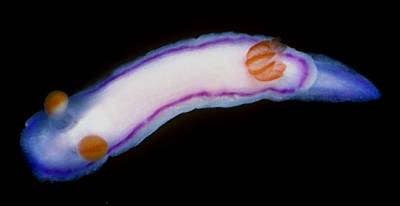
Thorunna daniellae
(Kay & Young, 1969)
Order: NUDIBRANCHIA
Suborder: DORIDINA
Family: Chromodorididae
DISTRIBUTION
Known from Hawaii and eastern Australia so probably a wide western Pacific distribution. Records in Forum from both sides of the Indian Ocean as well.
PHOTO
UPPER: Juvenile specimen 6mm long alive, with proportionally larger rhinophore clubs. Coffs Harbour Region, New South Wales, Australia, December 1990.
LOWER: Koumac, northern New Caledonia, 15mm long alive, October 1993. [left photo showing closeup of anterior and posterior mantle edge to show absence of mantle glands].
PHOTOS: Bill Rudman.
The elongate mantle has a relatively narrow mantle overlap and the relatively high body and foot extend to a tapering point some distance behind the posterior end of the mantle. The simple gills are arranged in a circle around the anal papilla and wave rhythmically. The mantle is white with a submarginal band of purple. The foot is translucent white with a purple, somewhat diffuse, submarginal band at the posterior end. The rhinophore stalk and the inner core of the club are translucent orange and the lamellae are bright orange. The gills are translucent white but the vessel at the edge of each gill, and the edge of the lamellae, are orange. It appears that this species lacks mantle glands - compare with Thorunna kahuna.
See Radular morphology.
References:
• Kay E.A., & Youmg, D.K. (1969) The Doridacea (Opisthobranchia Mollusca) of the Hawaiian Islands. Pacific Science, 23(2): 18-37.
• Rudman, W.B. (1984) The Chromodorididae (Opisthobranchia: Mollusca) of the Indo-West Pacific: a review of the genera. Zoological Journal of the Linnean Society, 81: 115-273.
• Rudman, W.B. (1990) The Chromodorididae (Opisthobranchia: Mollusca) of the Indo-West Pacific: further species of Glossodoris, Thorunna and the Chromodoris aureomarginata colour group. Zoological Journal of the Linnean Society, 100(3): 263-326.
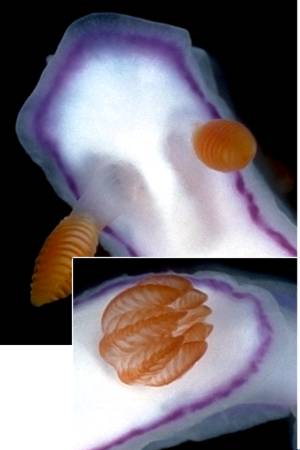
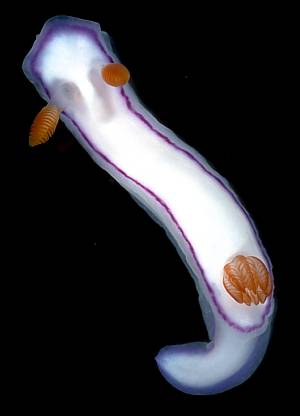
Rudman, W.B., 2003 (October 4) Thorunna daniellae (Kay & Young, 1969). [In] Sea Slug Forum. Australian Museum, Sydney. Available from http://www.seaslugforum.net/find/thordani
Related messages
Re: Thorunna daniellae from sthn Queensland
October 17, 2008
From: Gary Cobb
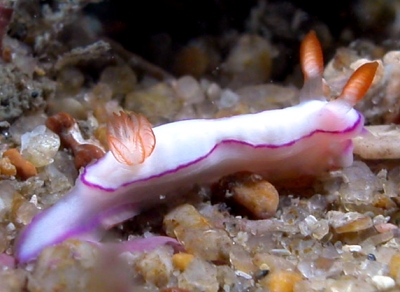
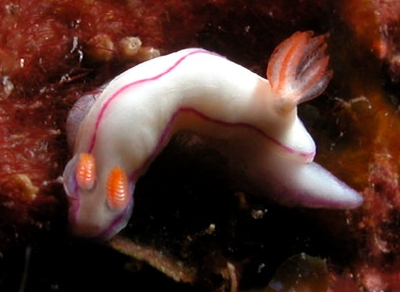
Concerning message #20927:
Hi Bill and everyone!
I thought you might like to have another record from this area of yet another species not recorded from here. This species is pretty common and has beeen found in most dive sites.
Locality: Old Woman Island, Mooloolaba, Sunshine Coast, 14 m, Queensland, Australia, Pacific Ocean, 14 October 2006, Subtidal. Length: 13 mm. Photographer: Gary Cobb and David Mullins.
Cheers
Gary
gary@nudibranch.com.au
Cobb, G.C., 2008 (Oct 17) Re: Thorunna daniellae from sthn Queensland. [Message in] Sea Slug Forum. Australian Museum, Sydney. Available from http://www.seaslugforum.net/find/21963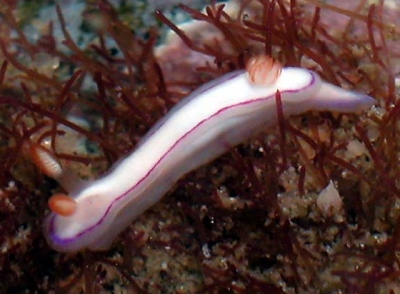
Thanks Gary,
Best wishes,
Bill Rudman
Thorunna daniellae from Bali, Indonesia
October 6, 2008
From: Paul Osmond
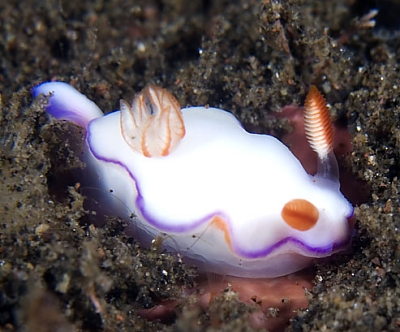
Hello,
I found this very small and colorful nudibranch moving across the rich soil on a muck dive in Tulamben Bay in Bali, Indonesia.
I thought it might be a color form of Chromodoris verrieri or Chromodoris albonares or similar as it seems to only have one purple band on the mantle and orangish-brown tinged rhinophores.
Locality: Tulamben Bay, 10m, Bali, Indonesia, 19 January 2007, Rich soil, muck dive. Length: 15mm. Photographer: Paul T. Osmond.
Yours,
Paul
www.deepseaimages.com
marriard@deepseaimages.com
Osmond, P.T., 2008 (Oct 6) Thorunna daniellae from Bali, Indonesia. [Message in] Sea Slug Forum. Australian Museum, Sydney. Available from http://www.seaslugforum.net/find/20927Dear Paul,
This is Thorunna daniellae. Looking through earlier messages I nootice that as in your animal, there are sometimes orange markings on the front of the mantle edge and on the sides in some specimens. The folding of the mantle into a pair of lobes on each side is quite characteristic of species of Thorunna when they are not crawling.
Best wishes,
Bill Rudman
Thorunna daniellae ? from Bali, Indonesia
January 3, 2007
From: Lindsay Warren
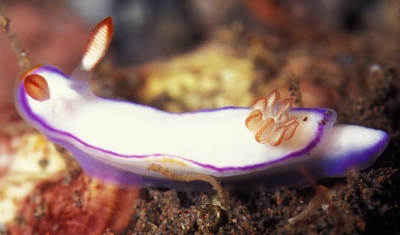
Dear Bill
Another addition I thought you might like for locality records for different species - It appears to be a form of Thorunna daniellae from Bali, Indonesia.
Locality: West of Scuba Seraya, Tukad Dabu, 26 ft / 7.8 m, NE Bali, Indonesia, Tropical Western Pacific, 9 May 2006 at 09:05, In open on silty slope near low growing reef. Length: 17 mm. Photographer: Lindsay Warren.
All the best
Lindsay
lwarren@datonomy.co.uk
Warren, L.C.R., 2007 (Jan 3) Thorunna daniellae ? from Bali, Indonesia. [Message in] Sea Slug Forum. Australian Museum, Sydney. Available from http://www.seaslugforum.net/find/19051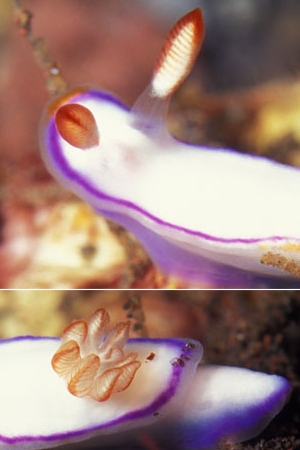
Dear Lindsay,
Thanks for this. It certainly looks generally like T. daniellae but the orange mark at the anterior end of the mantle is most unusual, although there are a couple of other photos on the Forum showing such an orange mark in this species. Interestingly there are other species which are characterised by such an orange mark, such as Thorunna florens. It's possible this animal is a specimen of T. florens without the orange lines. If so it makes me wonder whether T. daniellae is just the other extreme of a very variable species. Thorunna montrouzieri and T. purpuropedis can also have this anterior orange mark.
Best wishes,
Bill Rudman
Thorunna daniellae from Mariana Ids
December 19, 2003
From: Kenji Kobayashi
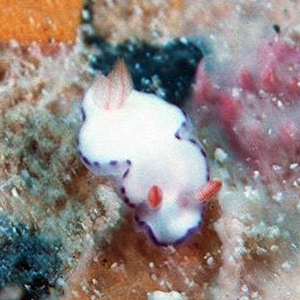
Dear Bill,
Could you identified this photo ?
It was taken in Saipan (Northern Mariana Ids).
Regards
Kenji Kobayashi
squall@gtepacifica.net
Kobayashi, K., 2003 (Dec 19) Thorunna daniellae from Mariana Ids. [Message in] Sea Slug Forum. Australian Museum, Sydney. Available from http://www.seaslugforum.net/find/11702Dear Kenji,
This is Thorunna daniellae. It does not usually have a row of submarginal purple spots around the edge of the mantle, but in Mike Miller's message there is a photo of an animal with traces of purple spots. Although it is a bit hard to see, the purple spots are some distance from the edge of the mantle, the actual mantle edge lacking any pigmentation and appearing almost transparent
Best wishes
Bill Rudman
Thorunna daniellae - radula
October 4, 2003
From: Bill Rudman
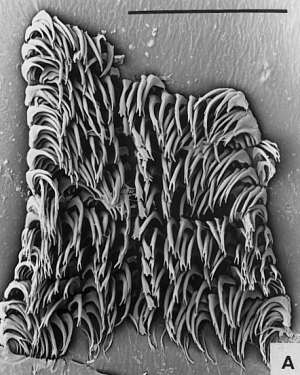
To accompany Rebecca Johnson's message about the radula of Thorunna kahuna here is a description of the radula of the very similarly looking T. daniellae from Rudman (1990).
The oral tube is five or six times the length of the buccal bulb, the radular sac being a small rounded bump between the muscle blocks in the postero ventral midline. The radular formula of the specimen 6mm long alive (AM C154376) is 14.0.14 x 17(+1)[from New South Wales, Australia]. The innermost right tooth has an elongate flattened blade with a rounded terminal cusp flanked by a similar but smaller rounded denticle on each side. All the other lateral teeth on the right side have an elongate shaft with a bifid tip formed from the reduction of the cusp to a rounded but elongate projection with a similar shaped outer denticle alongside.
The innermost lateral tooth on the left is quite different in shape and is apparently aberrant. It consists of a short quadrangular plate with a small triangular recurved hook on each of the upper corners (Fig. C). The other left lateral teeth mirror those on the right.
The jaw plates are not heavily chitinised and they are armed with scattered clusters of tapering unicuspid rodlets.
Like all species of the genus, the buccal armature is extremely small, when compared with other chromodorids. The oral tube is five or six times the length of the buccal bulb, and the radular sac is a small rounded bump between the muscle blocks in the postero ventral midline. The radular formula of a specimen 6mm long alive (AM C154376) was 14.0.14 x 17(+1). The radular teeth illustrated here are somewhat aberrant. The innermost right tooth has an elongate flattened blade with a rounded terminal cusp flanked by a similar but smaller rounded denticle on each side. All the other lateral teeth on the right side have an elongate shaft with a bifid tip formed from the reduction of the cusp to a rounded but elongate projection with a similar shaped outer denticle alongside. The innermost lateral tooth on the left side is quite different in shape and is apparently aberrant. It consists of a short quadrangular plate with a small triangular recurved hook on each of the upper corners Fig.C). The other left lateral teeth mirror those on the right. The jaw plates are not heavily chitinised and they are armed with scattered clusters of tapering unicuspid rodlets.
PHOTOS: A, whole radular ribbon. B, C, central and inner right region. D, mid-lateral teeth on right. E, outermost left lateral teeth. F, Jaw rodlets. Scale bars: A = 100 microns. B-F = 10 microns. Photos: G. J. Avern.
• Rudman, W.B. (1990) The Chromodorididae (Opisthobranchia: Mollusca) of the Indo-West Pacific: further species of Glossodoris, Thorunna and the Chromodoris aureomarginata colour group. Zoological Journal of the Linnean Society, 100(3): 263-326.
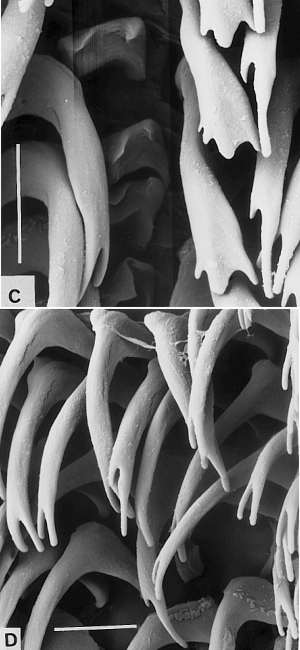
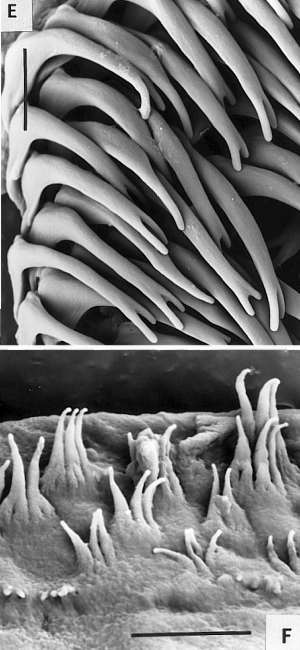
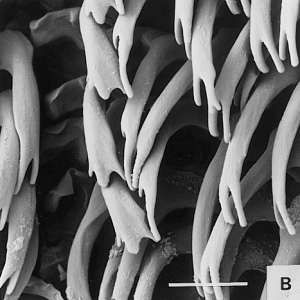
In the earlier account (Rudman, 1984) description of Australian specimens, the innermost lateral teeth were quite different in shape from those described by Kay & Young (1969) from Hawaii. The radula of the specimen illustrated here dissected is fortuitously aberrant, with the innermost right laterals being as described by me before from Australian material while the innermost left lateral teeth are very similar to those described by Kay & Young for their one specimen from Hawaii. As most species of Thorunna have innermost lateral teeth similar to those on the right side of this specimen (T. africana, T. furtiva, T. horologia - see Rudman, 1984), it would seem that the innermost left teeth of this specimen and the innermost right and left teeth of the Hawaiian specimen described by Kay & Young are aberrant.
Bill Rudman
Rudman, W.B., 2003 (Oct 4). Comment on Thorunna daniellae - radula by Bill Rudman. [Message in] Sea Slug Forum. Australian Museum, Sydney. Available from http://www.seaslugforum.net/find/11111Thorunna daniellae from Nelson Bay
January 3, 2003
From: Dave Harasti
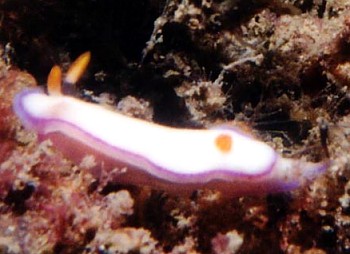
Hi Bill,
Happy New Year!
I found this species on the pipeline at Nelson Bay, New South Wales, eastern Australia last week (Dec 2002). The animal was about 3cm long and its the first time I've ever seen it here. Water depth was 8 metres and temp was 20 degree's. I'm pretty sure it's Thorunna daniellae, looks like another tropical visitor to the waters of Port Stephens!
Cheers,
Dave
diving@webone.com.au
Harasti, D., 2003 (Jan 3) Thorunna daniellae from Nelson Bay. [Message in] Sea Slug Forum. Australian Museum, Sydney. Available from http://www.seaslugforum.net/find/8707Thanks Dave,
Thorunna daniellae is one of those tropical animals which is not uncommonly found on the New South Wales coast. I have found it at times in Sydney.
Best wishes,
Bill Rudman
Thorunna cf. daniellae from South Africa
January 11, 2002
From: Valda Fraser
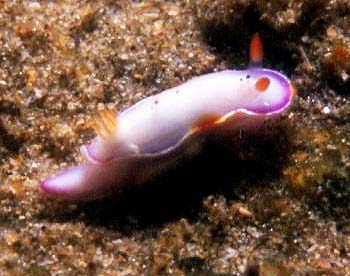
Dear Bill,
This Noumea looking nudibranch reminded me of you because it looks like your Thorunna horologia. Can you please identify it for me?
Locality: Pumula, south coast KwaZulu-Natal, South Africa, 28 m
Date: October 2001
Size: 8mm
Thanks.
Regards
Valda Fraser
valdafraser@mweb.co.za
Fraser,V., 2002 (Jan 11) Thorunna cf. daniellae from South Africa. [Message in] Sea Slug Forum. Australian Museum, Sydney. Available from http://www.seaslugforum.net/find/5595Dear Valda,
I am pretty sure this is Thorunna daniellae, which is quite an interesting find. This spepcies has previously been thought of as a western Pacific species but Mike Miller's photo from Bali, Indonesia of an animal with orange marks midway down the mantle edge certainly links your animal from the western Indian Ocean with his from the eastern side.
Best wishes,
Bill Rudman.
Thorunna daniellae with egg mass
November 26, 2001
From: Michael D. Miller
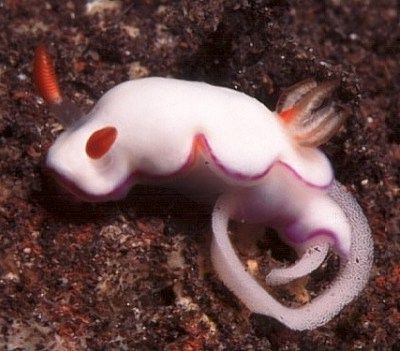
Dear Bill
In response to your request for more pics with egg masses, you will find attached an image of Thorunna daniellae with egg mass.
Location: Tulamben, Bali, Indonesia
Depth: 20 ft.
Date: Oct. 2000
Photographer: Michael Miller
Cheers;
Michael Miller
mdmiller@cts.com
Miller, M.D., 2001 (Nov 26) Thorunna daniellae with egg mass. [Message in] Sea Slug Forum. Australian Museum, Sydney. Available from http://www.seaslugforum.net/find/5719Thanks Mike,
Bill Rudman
